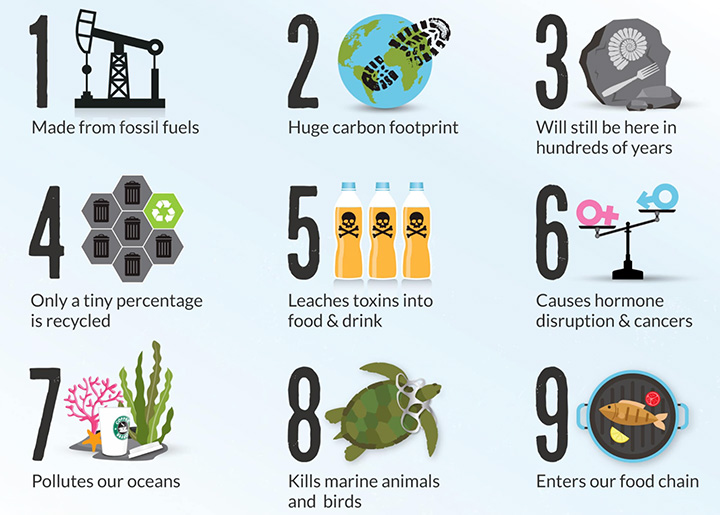Biodiversity & Environment
Single-Use Plastic
- 20 May 2021
- 5 min read
Why in News
Recently, a report was published which gave details of who makes single-use plastic, 130 million tons a year at last count, and who makes money from it.
- The report was published by Minderoo, a nonprofit organization based in Australia along with academics at the University of Oxford and the Stockholm Environment Institute.
Key Points
- Major Producers:
- Half of the world’s single-use plastic is made by 20 big companies.
- Two US companies followed by a Chinese-owned petrochemicals giant, and another one based in Bangkok.
- Half of the world’s single-use plastic is made by 20 big companies.
- Major Investors:
- Production is financed by financial services companies including banks.
- Governments are also big stakeholders in this industry. About 40% of the largest single-use plastic makers are partly owned by governments, including China and Saudi Arabia.
- Growth:
- Single-use plastic has been a very good business, and that’s projected to continue. In the next five years alone, production capacity is forecast to grow by 30%.
- Usage:
- There’s a huge disparity between richer and poorer nations:
- An average American uses and throws away 50 kilograms of single-use plastic every year whereas an average Indian uses less than one-twelfth of an American.
- There’s a huge disparity between richer and poorer nations:
- Concerns:
- Less Recycling:
- Only about 8% of plastic gets recycled in the US. It is far cheaper to make things out of newly produced plastic than from recycled plastic.
- Limited Efforts:
- State and municipal governments have had success in banning certain items like plastic grocery bags, foam cups and drinking straws. But the efforts focused on curtailing the production of single-use plastic have been limited so far.
- Advocacy efforts to persuade consumers to use less plastic have failed to gain traction.
- Less Recycling:
- Global Initiatives:
- European Union issued a directive calling for consumer brands to use at least 30% recycled content in plastic bottles by 2025.
- Indian Initiatives:
- In 2019, the Union government in a bid to free India of single-use plastics by 2022, had laid out a multi-ministerial plan to discourage the use of single-use plastics across the country.
- Plastic Waste Management Rules, 2016 which extended the responsibility to collect waste generated from the products to their producers and brand owners.
Single-Use Plastics
- About:
- Single-use plastics, or disposable plastics, are used only once before they are thrown away or recycled.
- These items are things like plastic bags, straws, coffee stirrers, soda and water bottles and most food packaging.
- Plastic is so cheap and convenient that it has replaced all other materials from the packaging industry but it takes hundreds of years to disintegrate.
- It is a huge problem. If we look at the data, out of 9.46 million tonnes of plastic waste generated every year in our country, 43% is single use plastic.
- Single-use plastics, or disposable plastics, are used only once before they are thrown away or recycled.
- Uses:
- The single-use plastic products also prevent the spread of infection.
- Instruments such as syringes, applicators, drug tests, bandages and wraps are often made to be disposable.
- Also, single-use plastic products have been enlisted in the fight against food waste, keeping food and water fresher for longer and reducing the potential for contamination.
- The single-use plastic products also prevent the spread of infection.
- Problems:
- Petroleum-based plastic is not biodegradable and usually goes into a landfill where it is buried or it gets into the water and finds its way into the ocean.
- In the process of breaking down, it releases toxic chemicals (additives that were used to shape and harden the plastic) which make their way into our food and water supply.
Way Forward
- Economically affordable and ecologically viable alternatives which will not burden the resources are needed and their prices will also come down with time and increase in demand.
- Need to promote alternatives like cotton, khadi bags and biodegradable plastics.
- More R&D (Research & Development) and finances for it, are needed to look for sustainably viable options.
- Citizens have to bring behavioural change and contribute by not littering and helping in waste segregation and waste management.







